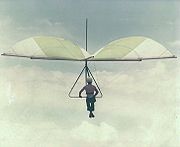
"Standard-Rogallo", 1975

The Rogallo flexible wing is a self-inflating system that was tested for Gemini and Apollo space capsule recovery.
The early experiments with gliding flight were made throughout the late 19th century by pioneers such as Otto Lilienthal. These early craft would now be considered hang gliders. The modern hang glider concept was strongly influenced by the NASA technician Francis Rogallo who in 1948 invented the 'flexible wing' or Rogallo wing.[1] NASA considered the Rogallo wing wing as an alternative recovery system for the Gemini space capsules but the idea was dropped in 1964.
American Barry Palmer was a pioneer in foot-launching hang gliders that used the seed wing from the art of the Rogallo-N.A.S.A.-Ryan team of engineers in the Parasev Paraglider Research Vehicle program. Palmer foot-launched a Rogalloish hang glider about seven years before Bill Moyes did similarly. Moyes used a more refined manufactured wing and flew further than Palmer did, but about 6 or 7 years later than Barry Palmer.

Parasev by NASA, 1962
1962-01-25. Dry lake towing tests of Rogallo wing. NASA-Dryden "Paraglider" Research Vehicle (Parasev). Milton O Thompson. [2]
Another principal player in the continuing development of the rogallo-wing-using hang glider was Australian John Dickenson, who in 1963, was shown a photo of Rogallo's fexible wing and set to build a portable and controllable glider, not just a water ski kite. Prior art by N.A.S.A.-Ryan teams in Parasev series of research vehicles had a keel, leading edge members, and cross-bar. (It may never be known if Dickenson did or did not actually even have a glance or word from another source or person about how far the Parasev program had prefaced his ingenuity, despite the possibility that he may not have seen (as he indicated) rigidized rogallo wings) Dickenson's Mark I had a keel, leading edges, a cross-bar and a fixed U-frame (two down sticks to control bar, making weight-shift control of the kite (glider when released from tow) (earlier art also used weight-shift to control hang glider flight using various-shaped frames holding pilot pods and pilot), thus bringing the Rogallo-seeded winged manned kites into the Australian water-ski-kite recreational world strongly; at first show, the dominant use was as a manned kite aircraft in contrast to the flat manned kites prevalent in his associated performers; the intent was to get into the glide mode for more exciting shows, at which time the system became on the terminal section of the flight, a hang glider. This kite was first flown in public at the Grafton Jacaranda Festival in September of 1963 by Rod Fuller while towed behind a motorboat. Refinements and versions lead to more releases from the kite mode to the glide mode. The Dickenson kite series demonstrated hang glider capabilities; finally in 1967 Bill Moyes became the first to foot-launch a hang glider using Dickenson A-frame development that came after the first U-frame by Dickenson.
Barry Palmer was the first to foot-launch a hang glider using a wing stemming from the Rogallo-team's wing. Certainly hang gliders were foot-launched from Otto Lilienthal in late 1800s. But Palmer used the rogalloish wing as did Moyes later. Bill Moyes became the first in Australia to foot-launch a hang glider that used Rogallo-type wing with an A-frame in 1967; there is a claim the hang glider used by Moyes for that flight was using some developments by Dickenson. Moyes' later foot-launch of a rogallo flexible-wing hang glider was striking longer than Palmer's 1960-1962 flights and showed that soaring flight was to be in the story soon.
Hang gliding then became popular world-wide, with the peak in the 1980s. An alternative to hang gliding is Paragliding since the gear is more easily transported although it offers lower performance and is prone to losing its shape and collapsing in thermal turbulence leading to most of the sports injuries and fatalities.
The Rogallo wing was subsequently improved in the mid-1970s with the invention of the Swallowtail design, several of which were used to impressive effect in the 1976 film Sky Riders. Other improvements in leading edge and materials design soon followed, improving the handling and efficiency of flexible-wing hang gliders.
However, "improving" a hang glider is one dimension of design activity; a lateral direction of "morphing" a design category results in variants that provide specific kinds of performance, utility, specific-purpose fulfillment; in this direction one may find hundreds of various hang glider designs within a type family. Consider those who were wanting "all the hang glider one could have from spending less than say $20 USD." Then a Batso or Bamboo Butterfly might fully satisfy; these are variants of the Rogallo theme. Though some "cable-leading edge" designs have more confined safe utility, some have found legitimate interest in the sub-family of rogallos. Modification of flight-safety decision are made in any case of flying.